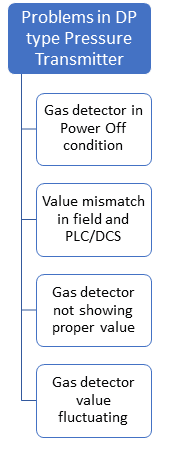Gas detectors are used in every plant as a safety barrier. Gas detectors should be always online and available so that any gas leaks can be identified timely. The Gas detectors like Cl2, H2S, CO, and HC are used widely.
This article describes some common problems and their troubleshooting for gas detectors.
Common Problems in Gas Detector
Some common problems with Gas detectors are :

Let us see the troubleshooting guidelines for all the problems mentioned above for gas detectors
Gas Detector Problem troubleshooting Guidelines
Follow the below-mentioned steps:
1. Gas detector in the power-off condition
Check the cable connection in the gas detector’s TB. All connections should be tight and properly lugged. Then check the supply voltage. If there is no voltage, then check the cable connections in the junction box and also in the marshaling cabinet. Do proper cable tightening if the cable is loose and proper lugging if any lug is damaged. Check the fuse healthiness in the marshaling cabinet. If the fuse is not ok, then replace the fuse with the same type of fuse. Replace the barrier if the barrier has faults. Also, check the cable healthiness if everything else is found ok.
2. Gas detector’s value mismatch in field and PLC/DCS
If the value in the gas detector field display is not matching with the value in the PLC/DCS, then check the range in the gas detector’s field display and in the system i.e. PLC/DCS. Take the reference of the datasheet for confirming the range.
3. Gas detector not showing the proper value
- Check the surrounding area for gas leakages. If any gas leakage is there, then the gas detector will detect the gas and show the value as per the gas detected.
- Check the gas detector for spider webs or dust particles in the sensor area. If spider web or dust is present, then clean the spider web or dust whichever is present.
- The gas detector should show zero ppm in the atmosphere if no gas leakage is present. If the gas detector is not showing zero ppm, then zero calibration should be done first and then span calibration should be checked.
- Check all necessary configurations like LRV, URV, and mA range as per the datasheet of the gas detector.
- Replace the gas detector’s sensor if the gas detector’s response is not proper.
4. Gas detector’s value fluctuates
- Check the surrounding area for gas leakages. If any gas leakage is there, then the gas detector will sense the gas and start showing the value.
- Check the surrounding area for moisture content. If the gas detector is installed near a location where there is high moisture content, then the value of the gas detector will fluctuate.
- Increase the damping factor in the gas detector if the fluctuations are very high when gas is detected.